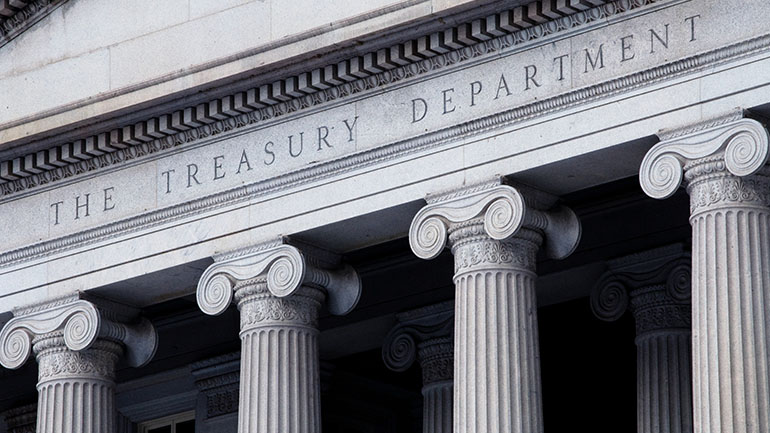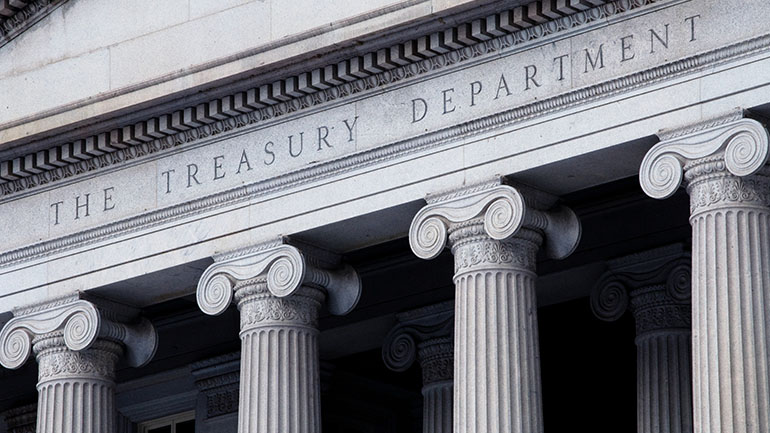Qu’est-ce qui gruge les taux des titres du Trésor?
Par : Gennadiy Goldberg, Molly Brooks, Jan Nevruzi
janv. 17, 2025 - 4 minutes 30 seconds
Aperçu :
- Les taux des bons du Trésor ont augmenté et les ventes se sont accélérées. Nous donnons des pistes d’explications à ce contexte.
- Compte tenu des réductions prévues du taux de la Réserve fédérale américaine (Fed), plusieurs facteurs seraient nécessaires pour que la hausse des taux de revenu se poursuive.
- La concrétisation de la politique de Washington peut être une source d’incertitudes, mais l’économie et l’inflation pourraient ne pas s’accélérer; il y a donc lieu de croire que les taux de la Fed restent stables durant le premier semestre de 2025.
Aller plus haut?
Les taux des bons du Trésor ont été réévalués nettement à la hausse dans le dernier mois et les ventes se sont accélérées depuis le début de la nouvelle année. Les taux nominaux à 10 ans ont augmenté de 60 points de base (pdb) depuis le début de décembre 2024, alors que les taux réels à 5 ans ont connu une hausse de 51 pdb au cours de la même période. La courbe s’est également accentuée de façon significative sur cette période, les taux de 5 à 30 ans ayant augmenté de 11 pdb. Plusieurs explications ont été données pour expliquer les ventes, que nous classons de la plus probable à la moins probable à notre avis :
Attentes accrues en matière de croissance
Notre décomposition de la plus récente hausse des taux sur 10 ans donne à penser que la hausse des taux réels (qui concorde avec la croissance) a été un facteur clé de l’augmentation. Les investisseurs ont constamment revu à la hausse leurs prévisions de croissance au cours des derniers mois, en partie en raison de la réélection du président Trump et d’une croissance économique beaucoup plus résiliente que prévu aux États-Unis.
Taux à 10 ans soutenus par les attentes accrues en matière de croissance et les craintes que la Fed soit moins conciliante
Révision des attentes de la Fed
Le marché a modifié de manière significative ses attentes quant aux baisses de taux de la Fed et prévoit actuellement des réductions de seulement 31 pdb en 2025 ainsi qu’un taux final d’un peu plus de 4 %. Depuis les creux de septembre 2024, la prédiction du marché pour le taux final des fonds a augmenté d’environ 120 pdb, ce qui laisse croire que les investisseurs s’attendent à des taux plus élevés pour une période prolongée.
Attentes en matière d’inflation
La réélection du président Trump et l’incertitude persistante quant à l’ampleur des nouveaux droits de douane ont également fait grimper les attentes en matière d’inflation. Bien que l’étendue des nouveaux droits de douane reste loin d’être claire, nous nous attendons à ce que ceux-ci laissent l’inflation plus élevée d’un point de pourcentage d’ici le milieu de 2025, à environ 3 %. Les taux neutres des titres du Trésor indexés sur l’inflation ont augmenté de 19 pdb dans le segment des titres à 10 ans depuis le début de décembre 2024, mais comme les taux des titres à 2 ans restent à seulement 2,85 %, il y a lieu de croire que le marché n’est pas en mesure se prononcer quant à l’étendue des droits de douane.
Les prévisions du marché relatives au taux final ont été revues nettement à la hausse
Attentes accrues en matière d’offre
La réélection du président Trump entraînera le renouvellement de la Tax Cuts and Jobs Act de 2017, et les marchés s’attendent déjà à des déficits plus élevés dans les années à venir. Bien que la prime à échéance des titres à 10 ans ait augmenté de 60 pdb par le passé, nous croyons qu’elle se dirige vers des niveaux plus normaux qui correspondent aux moyennes à plus long terme. Nous prévoyons que la prime à échéance des titres à 10 ans sera d’environ 50 pdb au cours des prochaines années.
La prime à échéance a augmenté de façon significative, mais demeure historiquement basse
Le manque de conviction des investisseurs contribue probablement à la hausse des taux d’intérêt, car l’incertitude demeure élevée. Les investisseurs attendent plus d’éclaircissements sur l’état de l’économie américaine et sur les annonces de politiques du président Trump, qui devraient arriver rapidement après son investiture.
Que faudrait-il pour que les taux augmentent davantage?
Alors que les taux à long terme ont continué d’augmenter, ceux à court terme ont eu de la difficulté à suivre le rythme. C’est l’une des conséquences des attentes en matière de baisse de taux par la Fed, le marché continuant de miser sur un taux final de 4 %. Nous croyons que plusieurs facteurs seraient nécessaires pour que l’augmentation des taux se poursuive :
Prévisions de hausses de taux
Étant donné que les marchés entrevoient actuellement une baisse de taux de 33 pdb en 2025, une autre augmentation obligerait probablement le marché à écarter d’autres réductions cette année et à se préparer à des hausses de taux. Même si les droits de douane pourraient faire grimper l’inflation à court terme, nous ne croyons pas que l’activité économique s’accélère de nouveau, ce qui rend une hausse de taux relativement peu probable cette année.
Politique budgétaire encore plus expansionniste
Le marché des bons du Trésor prévoit déjà des déficits élevés au cours des prochaines années. Cependant, si le Congrès adopte des projets de loi qui exigent des déficits encore plus élevés que prévu, les rendements pourraient subir encore plus de pressions à la hausse. Notons qu’en raison de leur faible majorité, les républicains à la Chambre des représentants devront recourir à des procédures de réconciliation pour adopter des projets de loi. Cela limitera la capacité d’augmenter sensiblement les déficits budgétaires, car ce processus exige que tout changement soit neutre sur le plan du déficit et prévient donc les fortes augmentations.
Politiques tarifaires bien pires que prévu
Si des droits de douane beaucoup plus élevés finissent par être imposés, les attentes en matière d’inflation pourraient augmenter considérablement, ce qui pousserait les taux à la hausse.
Quand les taux redescendront-ils?
Il y a des risques importants à l’horizon, et les données économiques à court terme seront probablement soumises à une saisonnalité résiduelle à la hausse. Cependant, nous ne croyons pas que l’économie ou l’inflation aux États-Unis s’accélèrent et nous ne prévoyons pas que les taux sur 10 ans atteignent un sommet dans la zone de 4,50 %-5,00 %. Cela dit, l’incertitude entourant la trajectoire de la politique monétaire a tenu de nombreux investisseurs à l’écart et pourrait faire en sorte que la volatilité reste élevée. Cette incertitude pourrait persister dans les mois à venir, car les investisseurs vont rester prudents dans les 100 premiers jours du mandat du président Trump, qui promet une avalanche d’annonces politiques.
Nous nous attendons actuellement à ce que la Fed maintienne ses taux au premier semestre de 2025, ce qui devrait maintenir les taux à 10 ans dans une fourchette de 4,50 à 5,00 %. Cependant, nous anticipons une reprise des réductions de la Fed au second semestre, à mesure que la croissance ralentira. Cela devrait faire baisser les taux au cours de l’année. Les bons du Trésor à 10 ans affichent maintenant un portage positif et un taux de revenu décroissant favorable, de sorte que les investisseurs peuvent considérer la détention d’obligations du Trésor américain à 10 ans aux niveaux actuels comme une proposition de valeur attrayante et nous nous attendons à ce que les rendements à 10 ans terminent 2025 à 3,8 %.
Les clients abonnés peuvent lire le rapport complet, intitulé, What's Eating Treasury Yields?, sur le Portail unique de Valeurs Mobilières TD











